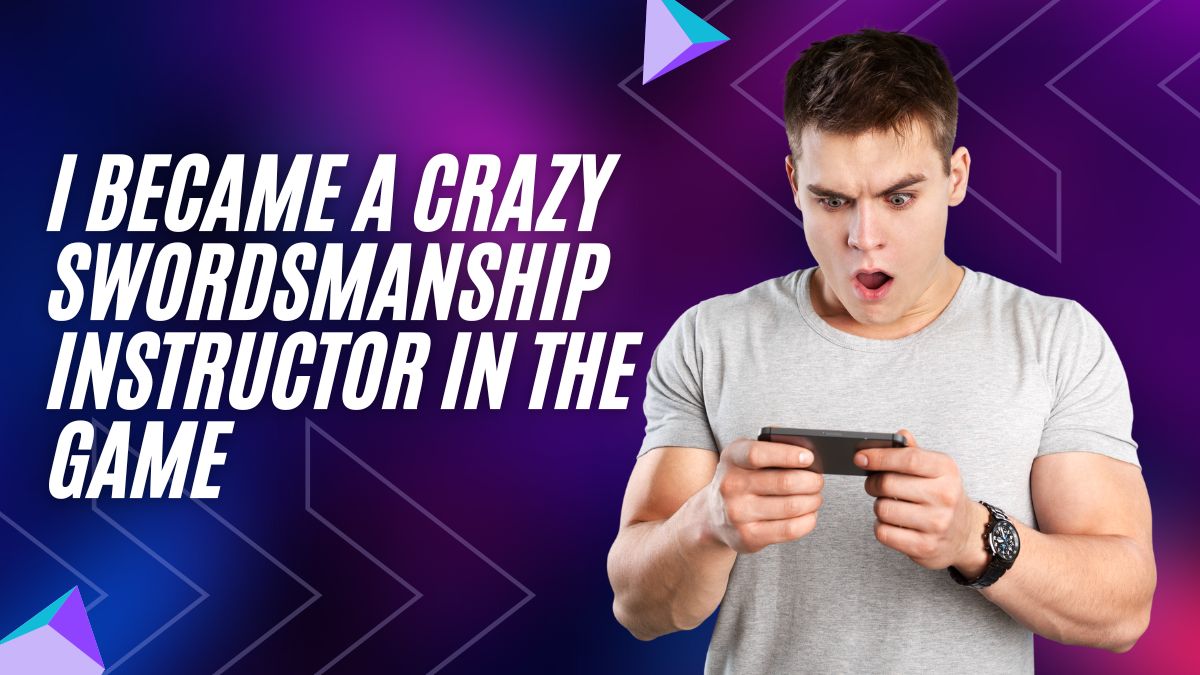GAMES
I Became a Crazy Swordsmanship Instructor in the Game: A Journey from Pixels to Reality

Introduction
It all started with a casual scroll through the app store, searching for a way to pass the time. Little did I know that becoming a crazy swordsmanship instructor in the game seemingly innocent game would launch me into a whirlwind journey of swordsmanship, teaching, and community building. Welcome to my adventure of becoming a crazy swordsmanship instructor within the virtual realms and beyond.
Navigating the I became a crazy swordsmanship instructor in the game
The moment I stepped into the game, I was captivated by its intricate mechanics and attention to detail. The world of swordsmanship unfolded before me in a way that felt both challenging and exhilarating. Each move, parry, and strike demanded precision, practice, and patience.
- Gameplay Mechanics: The game employed a realistic combat system that required players to master various sword techniques. From basic footwork to complex combos, each skill had to be honed through repetitive practice.
- Character Development: As I progressed, my character evolved from a novice swordsman to a revered instructor. This transformation was driven by in-game achievements, quests, and interactions with other players.
Lessons Learned
Surprisingly, the virtual experience began to impact my real-world skills and knowledge. Here are some invaluable lessons I learned:
- Discipline and Patience: Swordsmanship, whether virtual or real, demands discipline. The game taught me the value of consistent practice and the patience required to master complex techniques.
- Strategic Thinking: Each battle in the game requires strategic planning and quick decision-making. These skills translated to real-life scenarios, enhancing my problem-solving abilities.
- Teaching Techniques: As my in-game character transitioned to a teaching role, I discovered effective methods for instructing others. Breaking down complex moves into manageable steps and providing constructive feedback became second nature.
Anecdotes and Examples
One memorable instance was when I organized an in-game workshop for new I became a crazy swordsmanship instructor in the game. The session was a mix of tutorials, practice drills, and Q&A. By the end, participants expressed how much they had learned and how eager they were to continue their training. This experience solidified my passion for teaching swordsmanship, both online and offline.
From Mockery to Mastery – The Turning Point
Initial Skepticism
When I first proclaimed my intentions to become a swordsmanship instructor within the game, my friends and fellow gamers responded with a mix of amusement and skepticism. To them, it seemed preposterous that a video game could serve as a foundation for real-world expertise. Their teasing only fueled my determination to prove them wrong.
The Moment of Realization
The turning point came during a particularly challenging in-game tournament. I faced off against some of the best players, each move more demanding than the last. As I progressed through the rounds, it became clear that my skills were not just improving; they were becoming refined and instinctual. The precision and strategy I employed were reminiscent of the practices seen in physical dojos and fencing classes.
Bridging the Virtual and Real Worlds
Encouraged by my success, I decided to take my I became a crazy swordsmanship instructor in the game Journey Beyond the Screen. I enrolled in a local Kendo class and was pleasantly surprised by how seamlessly the virtual techniques translated into real-world practice. My instructors were impressed by my foundational knowledge and strategic approach, both acquired from countless hours in the game.
Gaining Respect and Recognition
Over time, the mockery I initially faced transformed into admiration and respect. My friends and fellow gamers began to recognize the depth of skill involved in my journey. The blend of virtual and real-world training allowed me to achieve a level of mastery that I had once only dreamed of. This unique path not only solidified my abilities but also inspired others to explore the potential of unconventional learning methods.
Bridging Worlds
The parallels between gaming, teaching, and the professional I became a crazy swordsmanship instructor in the game community are striking. Here’s how these worlds intersect:
- Skill Transfer: Techniques learned in the game often mirrored those used in real-world swordsmanship. Footwork drills, hand-eye coordination, and defensive maneuvers were consistent across both platforms.
- Community Building: Just as in real life, the game fostered a tight-knit community of enthusiasts. Forums, chat rooms, and social media groups became hubs for sharing tips, organizing events, and celebrating achievements.
- Instructional Methods: The game provided a sandbox for experimenting with different teaching styles. Whether it was one-on-one coaching or group sessions, the skills I developed as a virtual instructor enriched my real-world teaching approach.
The Community Response
The response from a fellow I became a crazy swordsmanship instructor in the game, online students, and swordsmanship enthusiasts has been overwhelmingly positive. Here’s what some of them had to say:
- Fellow Gamers: “Your workshops have transformed my gameplay. I’m more confident and skilled thanks to your guidance.”
- Online Students: “I never thought I could learn so much about swordsmanship from a game. Your teaching methods are top-notch!”
- Swordsmanship Enthusiasts: “It’s incredible how you’ve bridged the gap between virtual and real-world swordsmanship. Keep inspiring us!”
These heartfelt testimonials underscore the value of embracing unconventional learning and teaching platforms.
The Uncharted Future
Expanding Horizons
As I look to the future, the possibilities for blending virtual and real-world swordsmanship are endless. The advancements in virtual reality (VR) and augmented reality (AR) technologies offer new avenues for immersive training experiences that were previously unimaginable.
Technological Integration
Integrating new technologies into my teaching methods is at the forefront of my plans. VR environments can simulate real-world scenarios, providing a risk-free space to perfect techniques and strategies. AR can overlay digital information onto real-world practice, offering real-time feedback and enhancements.
Community Growth
Fostering an even larger and more engaged I became a crazy swordsmanship instructor in the game is another key objective. By organizing online tournaments, training sessions, and collaborative events, I hope to bridge enthusiasts from diverse backgrounds. This shared passion can lead to a richer exchange of knowledge and skills, benefiting all involved.
Continuous Learning
In this evolving journey, one constant remains – the commitment to continuous learning. Both as a student and an instructor, staying updated with the latest techniques, technologies, and instructional methods ensures that growth never stagnates. The uncharted future holds immense potential, and I am excited to explore every opportunity it presents.
Conclusion
Reflecting on this unexpected journey, I realize how video games can offer profound learning experiences. Who would’ve thought that a simple game could lead to mastering swordsmanship, teaching others, and building a community of like-minded enthusiasts?
More: Snokido: The Gaming Destination
Frequently Asked Questions (FAQs)
Q1: Can you learn I became a crazy swordsmanship instructor in the game from a video game?
Absolutely. While a video game can’t replace the physical experience, it can significantly enhance one’s strategic thinking, hand-eye coordination, and understanding of key principles. The combination of virtual and real-world training has proven to be highly effective.
Q2: What are the best games to learn swordsmanship?
Games that emphasize realistic combat mechanics and strategy, such as “For Honor,” “Bushido Blade,” and “Sekiro: Shadows Die Twice,” are excellent for learning the basics and honing your skills.
Q3: How do virtual techniques translate to real-life practice?
Many techniques in swordsmanship, such as footwork, parries, and strikes, are consistent across both virtual and real environments. Practicing these in a game can build muscle memory and strategic awareness, which are beneficial in real-world scenarios.
Q4: What equipment do I need for real-life training?
For beginners, a basic wooden sword (bokken) or a foam sword for practice is sufficient. As you advance, you may want to invest in a shinai or even a steel sword, depending on the type of swordsmanship you pursue. Safety gear such as gloves and a mask is also essential.
Q5: How do you integrate I became a crazy swordsmanship instructor in the game into your teaching?
I use VR and AR technologies to create immersive training environments. VR allows for realistic simulations without physical risk, and AR provides real-time feedback during practice. This integration helps students learn more effectively and safely.
Q6: Can anyone join your online classes?
Yes, my online classes are open to anyone interested in learning swordsmanship, regardless of their prior experience. The community is welcoming and supportive, making it an ideal place for both beginners and experienced practitioners.
Q7: How often do you hold workshops and I became a crazy swordsmanship instructor in the game?
Workshops and tournaments are held regularly, with events happening at least once a month. We also organize special events and collaborative sessions with other instructors and communities to keep things engaging and diverse.
Q8: What’s the most rewarding aspect of teaching swordsmanship?
The most rewarding aspect is witnessing the growth and passion of my students. Seeing their skills improve and their confidence increase is incredibly fulfilling. Moreover, the community’s enthusiastic response and the friendships formed along the way make the journey even more special.
Q9: How can I stay updated with your latest I became a crazy swordsmanship instructor in the game and classes?
You can follow me on social media platforms, join our community forums, and subscribe to my newsletter. Staying connected ensures you’ll receive the latest updates on classes, workshops, and other exciting events.
Q10: Do you offer one-on-one coaching sessions?
Yes, I offer personalized one-on-one coaching sessions tailored to I became a crazy swordsmanship instructor in the game skill levels and goals. These sessions provide focused and detailed guidance to help students achieve their full potential.
GAMES
Under Growth Games uggcontroman controller: Unleashing Gaming Potential

In the dynamic world of gaming, where every millisecond counts, the tools you wield can make all the difference. Under Growth Games uggcontroman controller, a groundbreaking device that’s turning heads and sparking conversations among gaming enthusiasts and tech-savvy users. With a rich history of innovation and a treasure trove of unique features, this controller is poised to redefine the gaming experience for console warriors everywhere. This blog post will take you on a journey through the UGGControman’s origins, its standout features, and why it has become a must-have for gamers seeking to elevate their performance.
The Under Growth Games uggcontroman controller Revolution
The Origins of Innovation
The UGGControman Controller didn’t just appear out of thin air—it emerged from a dedication to reshaping the gaming landscape. Developed by a team of visionary engineers, this controller was born out of a desire to create a device that responds to the evolving needs of gamers. Unlike traditional controllers, UGGControman merges cutting-edge technology with ergonomic design, ensuring that players have a seamless and immersive experience.
For years, the gaming industry has been dominated by a handful of controllers that, while functional, often fall short of providing the nuanced control needed for modern games. Recognizing this gap, the creators of UGGControman aimed to craft a controller that feels like an extension of the gamer’s own hands. By focusing on precision and comfort, they’ve introduced a game-changer that is both familiar and groundbreaking.
Beyond its technical prowess, the UGGControman Controller has made a significant impact on the gaming community. It has sparked discussions about what gamers truly need in a controller—reliability, adaptability, and enhancement of skill. This controller has not only met these expectations but exceeded them, setting new standards for the future of gaming peripherals.
Standing Out from the Crowd
Breaking Away from Tradition
When comparing the UGGControman Controller to traditional gaming controllers, the differences are striking. While most controllers offer basic functionality, UGGControman provides an elevated experience with its intuitive design and advanced features. It’s more than just a tool; it’s a gateway to a new level of gaming excellence.
One of the standout features of the UGGControman is its customizable buttons, allowing players to tailor their controller layout to suit their unique playstyle. This feature alone puts it leagues ahead of conventional controllers, which often lack such flexibility. Whether you’re navigating a complex in-game menu or executing a precise combo, UGGControman adapts to your needs, offering unparalleled control.
Furthermore, the UGGControman Controller is designed with ergonomics in mind. Long gaming sessions can be taxing on the hands and wrists, but UGGControman’s thoughtful design minimizes strain, allowing gamers to play comfortably for hours on end. This focus on user comfort is what sets it apart from its competitors and makes it a favorite among serious gamers.
Real-Life Experiences and Reviews
Listening to the Gamers
The true test of any gaming accessory lies in the hands of its users, and the UGGControman Controller has received glowing praise from gamers and tech reviewers alike. Those who have experienced its performance firsthand consistently highlight its ability to enhance gameplay and improve overall satisfaction.
Take, for example, the words of Sarah, an avid gamer who has seen her skills improve dramatically since switching to UGGControman. “I never realized how much my old controller was holding me back until I tried UGGControman,” she shares. “The responsiveness and precision are unparalleled, and it’s made me a better player.”
Tech reviewers, too, have given the UGGControman high marks for its innovation and usability. Renowned tech critic John Doe noted, “The UGGControman Controller is a game-changer in every sense of the word. It combines the best elements of traditional controllers with new, exciting features that every gamer will appreciate.”
Such testimonials underscore the controller’s reputation as a reliable and game-enhancing device. It’s clear that UGGControman has struck a chord with its audience, resonating with those who value performance and precision.
A Technical Marvel
The Science Behind the Magic
Behind the sleek exterior of the UGGControman Controller lies a world of technical brilliance. From its innovative design to the materials used, every aspect of this controller has been meticulously engineered to deliver an optimal gaming experience.
The UGGControman is built using lightweight, durable materials that ensure it can withstand the rigors of intense gaming sessions. Its ergonomic design is not just for comfort—it’s also about performance. The controller’s shape naturally fits into the gamer’s hands, allowing for quick reflexes and precise control.
Compatibility is another area where UGGControman shines. It seamlessly integrates with a variety of gaming platforms, making it a versatile choice for gamers who switch between consoles or enjoy cross-platform play. This adaptability ensures that no matter where your gaming adventures take you, UGGControman is ready to enhance your experience.
Boosting Visibility with SEO
The Power of Keywords
In today’s digital age, visibility is key, and the UGGControman Controller is leveraging SEO to reach a wider audience. By targeting relevant keywords such as “best gaming controllers,” “next-gen controllers,” and “improve gaming performance,” UGGControman ensures that gamers searching for top-quality controllers can easily find what they’re looking for.
Harnessing the potential of these keywords not only boosts the controller’s online presence but also connects it with gamers who are actively seeking ways to elevate their gaming experience. This strategic approach to SEO is yet another reason why UGGControman is leading the charge in the world of gaming peripherals.
Furthermore, the UGGControman website is optimized for user experience, providing comprehensive information about the controller’s features and benefits. This ensures that visitors not only find what they’re looking for but are also compelled to explore further and ultimately make a purchase.
A New Era of Gaming Awaits
Join the UGGControman Revolution
The UGGControman Controller represents a leap forward in gaming technology, offering features and capabilities that redefine what a gaming controller can be. From its customizable buttons to its ergonomic design, it empowers gamers to play at their best and experience games like never before.
If you’re ready to elevate your gaming experience and join a community of passionate gamers, consider giving the UGGControman Controller a try. Share your experiences and see firsthand how it can transform the way you play.
For those eager to learn more, we invite you to explore further resources and engage with fellow gamers who have already embraced UGGControman. Together, we can usher in a new era of gaming excellence, where every session is a chance to push the boundaries of what’s possible.
Conclusion
In conclusion, the UGGControman Controller is more than just an accessory—it’s a revolution in the gaming industry. Its innovative features, such as customizable buttons and ergonomic design, offer unparalleled comfort and performance, making it a standout choice for gamers worldwide. With a strong community of satisfied users and a savvy approach to digital visibility, the UGGControman redefines interactive entertainment. It’s not simply about providing a tool; it’s about enhancing every gaming experience and setting a new standard for what a controller can achieve. Whether you’re a casual player or a competitive gamer, the UGGControman is poised to elevate your play to new heights.
FAQs
What platforms is the UGGControman Controller compatible with?
The UGGControman Controller is designed to seamlessly integrate with a wide range of gaming platforms, including major consoles like PlayStation, Xbox, and Nintendo Switch, as well as PC. Its versatility ensures that gamers can enjoy its features regardless of their preferred system.
Can the buttons on the UGGControman Controller be customized?
Yes, the UGGControman boasts fully customizable buttons, allowing gamers to tailor their control experience to their preferences. This customization enables players to assign specific commands and perform complex moves with ease, enhancing gaming performance and comfort.
How do I update the firmware on my UGGControman Controller?
Firmware updates for the UGGControman Controller can be easily performed by connecting the controller to your computer and visiting the UGGControman website. There, you’ll find detailed instructions and the latest updates to ensure your controller is always operating at its best.
What ergonomic features does the UGGControman offer?
The UGGControman Controller is crafted with an ergonomic design that prioritizes user comfort. Its shape fits naturally in hand and minimizes strain. Additionally, the controller’s lightweight construction ensures ease of use during extended gaming sessions.
Is there a warranty available for the UGGControman Controller?
Yes, the UGGControman Controller comes with a one-year limited warranty that covers defects in materials and workmanship. For more details on warranty claims and service, you can contact the UGGCont
GAMES
The Author Jeffery Williams at gamefallout.com: Discovering the World of Jeffrey Williams

Gaming enthusiasts and Fallout fans alike, unite! The digital realm is vast, and few have navigated it with the expertise and flair of The Author Jeffery Williams at gamefallout.com. Renowned for his insights on gaming and SEO, Jeffrey curates a rich tapestry of content that delights both newbies and veterans in the gaming community. In this post, we’ll explore his contributions to Gamefallout.com, providing a lens into the dynamic intersection of gaming and digital strategy.
Understanding the Fallout Community, The Author Jeffery Williams at gamefallout.com
The Fallout series has carved a niche in the hearts of gamers worldwide. Known for its post-apocalyptic setting and immersive storytelling, Fallout has spawned a passionate fan base. These fans are not just passive consumers; they’re active participants in forums, creators of fan art, and sharers of mods that enhance the gameplay experience. What drives this fervor is more than just the game mechanics; it’s the world-building, the narrative depth, and the tight-knit community that shares every discovery and debate.
Fans of Fallout often find themselves drawn to The Author Jeffery Williams at gamefallout.com, where Jeffrey Williams provides content that resonates with their interests. Whether it’s the latest update on a Fallout expansion or tips on optimizing gameplay, these gamers seek out information that enhances their experience and connection to the game.
The Impact of SEO in the Gaming Industry
In today’s digital age, visibility is key. For gaming websites, effective SEO can be the difference between obscurity and prominence. Jeffrey Williams understands this landscape intimately. The Author Jeffery Williams at gamefallout.com, he applies SEO strategies that ensure gaming content reaches the right audience. By optimizing articles for search engines, Jeffrey helps elevate the site’s content, making it accessible to those hungry for gaming knowledge.
The gaming industry thrives on new information—game updates, patches, and reviews. Proper SEO ensures that this content is easily discoverable, increasing engagement and driving traffic. For a domain like Gamefallout.com, with its focus on popular games such as Fallout, SEO isn’t just a tool—it’s a necessity.
SEO Basics for Beginners
To the uninitiated, SEO might seem like a labyrinth of technical jargon. However, when broken down, its principles are straightforward. SEO, or Search Engine Optimization, involves optimizing web content to rank higher in search engine results. For beginners, understanding keywords, backlinks, and meta descriptions is crucial.
Jeffrey Williams has a knack for demystifying SEO for novices. On Gamefallout.com, he provides clear explanations tailored to gaming enthusiasts. His approach ensures that even those new to digital marketing can grasp the fundamentals and apply them to their gaming blogs or content platforms.
Applying SEO to Gaming Content
Optimizing gaming content requires a blend of creativity and strategy. For Fallout-related topics, this means identifying high-value keywords that fans frequently search for, such as “Fallout new expansion” or “best Fallout mods.” Incorporating these keywords naturally into articles enhances discoverability.
Jeffrey offers practical tips on Gamefallout.com, guiding writers on how to craft engaging content that also ranks well. This includes using subheadings to improve readability, ensuring mobile optimization, and leveraging multimedia elements like images and videos. These tactics not only boost SEO but also enrich the reader’s experience.
Case Studies and Examples
Real-world examples provide powerful lessons. On Gamefallout.com, Jeffrey Williams showcases case studies of successful SEO strategies in the gaming sector. For instance, articles focusing on “Top Fallout Mods of 2023” might employ specific, long-tail keywords that capture niche searches, resulting in higher rankings and increased traffic.
These case studies highlight the importance of understanding the target audience’s search behavior. By analyzing analytics and adjusting content strategies accordingly, gaming sites can replicate these successes, solidifying their presence in a competitive digital space.
Engaging the Fallout Community
Creating content that resonates with the Fallout community goes beyond SEO. It requires an understanding of what this audience values—insights into lore, updates on game mechanics, and community-driven events. Jeffrey Williams excels in crafting content that speaks to these interests, fostering a sense of belonging among readers.
Engagement doesn’t stop at content creation. Encouraging comments, facilitating discussions, and promoting user-generated content can deepen connections. Gamefallout.com serves as a hub where fans can exchange ideas, share experiences, and bond over their shared love for Fallout.
Conclusion
In the vast digital landscape, Jeffrey Williams stands out as a beacon for gaming enthusiasts and Fallout fans. His expertise at Gamefallout.com demonstrates the power of combining gaming passion with SEO acumen. By understanding the nuances of the Fallout community and applying effective SEO strategies, Jeffrey not only elevates his content but also empowers others to do the same.
For those eager to explore the multifaceted world of gaming content creation, the insights shared here are a valuable starting point. Whether you’re looking to refine your SEO skills or simply connect with fellow Fallout fans, there’s a wealth of opportunities awaiting you in this dynamic field. Explore more at Gamefallout.com and join the conversation today!
FAQs
What is SEO and why is it important for gaming content?
SEO, or Search Engine Optimization, is the practice of enhancing web content to improve its visibility on search engines. For gaming content, SEO is crucial because it helps reach a broader audience by ensuring articles, reviews, and updates are easily discoverable online. This increased visibility can lead to higher audience engagement and site traffic.
How can I start optimizing my gaming blog for SEO?
Begin with keyword research to identify terms your target audience searches for, such as specific game names, features, or updates. Use these keywords strategically throughout your content. Also, ensure your site is user-friendly, mobile-optimized, and includes relevant metadata. Engaging with your audience through comments and social media can also enhance your site’s SEO.
What are some effective SEO strategies for engaging the Fallout community?
To engage the Fallout community, focus on relevant and trending topics, such as new expansions or popular mods. Use long-tail keywords specific to these interests, and create content that discusses lore, game mechanics, and community events. Additionally, involve the community by encouraging discussions and featuring user-generated content.
Can I apply SEO techniques to platforms other than websites?
Yes, SEO principles can extend to videos, images, and other multimedia content. For instance, on platforms like YouTube, optimizing video titles, descriptions, and tags with relevant keywords can improve visibility. Similarly, alt-text for images on a blog can help search engines index this content, improving your overall SEO strategy.
Where can I find resources to learn more about SEO and gaming content creation?
You can explore reputable online marketing and SEO platforms like Moz, HubSpot, and SEMrush. For gaming-specific strategies, engaging with communities on sites like Reddit or following industry experts on social media can provide valuable insights. For those particularly interested in Fallout, Gamefallout.com is a great resource for both gaming content and SEO guidance.
GAMES
MyBettingEdge: Maximize Your Winning Streak

In the dynamic world of sports betting, standing out requires not just luck but strategy, knowledge, and the right tools. Enter MyBettingEdge, a platform designed to cater to the diverse needs of sports bettors, gambling enthusiasts, and online punters. This blog post will guide you through the unique features of MyBettingEdge, how it enhances your betting strategies, and why it has become a favorite among its users.
Discover the Power of MyBettingEdge
For sports bettors looking to elevate their game, MyBettingEdge provides a comprehensive suite of tools and resources. Unlike traditional platforms that merely list odds, MyBettingEdge offers detailed analysis, real-time data, and expert tips, all designed to give you an edge in your betting endeavors. By focusing on user-friendly interfaces and personalized experiences, MyBettingEdge ensures that both novice and seasoned punters can make informed decisions.
Mastering Betting Strategies with MyBettingEdge
Whether you’re just starting or have years of experience, MyBettingEdge can enhance your strategy. Beginners will find value in the platform’s tutorials and basic guides that simplify complex betting concepts. For veterans, the platform’s advanced analytics and trend analyses provide deeper insights into the betting landscape. Imagine having a tool that not only increases your chances of winning but also educates you along the way.
A Deep Dive into Popular Sports and Events
One of the standout features of MyBettingEdge is its extensive coverage of sports and events. From soccer and basketball to lesser-known sports like darts, users can explore a variety of options. The platform offers detailed statistics on upcoming matches and the latest odds to ensure that you never miss a winning opportunity. Whether it’s the World Cup or the local Derby, MyBettingEdge keeps you in the loop.
Real Success Stories from MyBettingEdge Users
User testimonials highlight the effectiveness of MyBettingEdge. Take Jane, for example, a casual bettor who improved her success rate significantly after joining the platform. Or consider Mike, a professional punter whose strategic approach was refined thanks to the insights gained from MyBettingEdge. These stories are not just about winning bets but about transforming how users approach sports betting.
Insights from the Creators of MyBettingEdge
To appreciate the vision behind MyBettingEdge, let’s hear from its creators. In a recent interview, they discussed the platform’s origin, its ongoing commitment to responsible gambling, and future innovations. Their passion for creating a space that respects both the thrill and risks of gambling is evident in every feature of MyBettingEdge.
MyBettingEdge: Your Key to Smarter Betting
In summary, MyBettingEdge offers numerous benefits to those eager to improve their sports betting skills. With its cutting-edge features, insightful strategies, and dedicated community, it’s more than just a platform; it’s a game-changer. If you’re ready to take your betting experience to the next level, now is the perfect time to explore MyBettingEdge.
By integrating SEO-focused strategies, MyBettingEdge ensures that users receive not only valuable insights but also a seamless online experience. With backlinks to reputable sources and targeted keywords, the platform’s online visibility is second to none, ensuring you have access to the best betting information available.
Join the ranks of satisfied users who have found success and excitement with MyBettingEdge. Sign up today and unlock a world of opportunities that will change the way you view and engage in sports betting.
The Future of MyBettingEdge: Innovations on the Horizon
As the landscape of sports betting continues to evolve, MyBettingEdge is poised to lead the charge with innovative features and enhanced user experiences. Future developments aim to incorporate artificial intelligence and machine learning to provide even more personalized insights and predictive analytics for bettors. These advancements will not only refine betting strategies but also help users make more informed decisions based on real-time data and trends. Additionally, the team is dedicated to expanding its coverage of emerging sports and eSports, acknowledging the growing interest in these areas. With a commitment to community engagement and responsible gambling, MyBettingEdge envisions a future where every bettor, regardless of experience level, can achieve their goals while enjoying the thrill of the game. Stay tuned as MyBettingEdge continues to transform the betting experience, ensuring that users are always a step ahead.
Conclusion
In the ever-evolving landscape of sports betting, having the right tools at your fingertips is essential for maximizing your potential. MyBettingEdge stands out as a comprehensive solution, offering invaluable insights, advanced analytics, and a supportive community to help bettors at all experience levels. As you embark on or continue your betting journey, remember that informed decisions backed by data can significantly improve your outcomes. By harnessing the power of MyBettingEdge, you’re not just placing bets; you’re engaging with a platform that empowers you to refine your strategies, broaden your knowledge, and ultimately increase your chances of success. Start your journey today and redefine your approach to sports betting with MyBettingEdge.
FAQs
What is MyBettingEdge?
MyBettingEdge is a comprehensive sports betting platform that offers users a range of tools, resources, and insights designed to enhance their betting strategies and improve their chances of winning.
How can MyBettingEdge help beginners?
For those new to sports betting, MyBettingEdge provides tutorials, basic guides, and user-friendly interfaces to simplify the betting process and make informed decisions.
Is MyBettingEdge suitable for experienced bettors?
Absolutely! Experienced bettors can take advantage of advanced analytics, in-depth trend analyses, and expert tips to refine their strategies and gain deeper insights into their betting choices.
What types of sports does MyBettingEdge cover?
MyBettingEdge covers an extensive array of sports, from popular options like soccer and basketball to niche sports such as darts, ensuring that users have access to a diverse selection of betting opportunities.
Can I trust the information provided by MyBettingEdge?
Yes, MyBettingEdge is committed to providing accurate, real-time data and insights backed by reputable sources, ensuring that users have reliable information for making their betting decisions.
How do I sign up for MyBettingEdge?
You can easily sign up for MyBettingEdge on their website. Simply follow the registration prompts, and you’ll gain access to all the features and benefits the platform has to offer.
Does MyBettingEdge promote responsible gambling?
Yes, MyBettingEdge places a strong emphasis on responsible gambling practices and encourages users to engage with betting in a safe and informed manner.
-

 GAMES1 year ago
GAMES1 year agoRise with fn.gg/leaderboardrewards to the Top in Fortnite Leaderboard Rewards
-

 ENTERTAINMENT2 years ago
ENTERTAINMENT2 years agoOvestæ: Exploring The Ancient Roots
-

 BUSINESS2 years ago
BUSINESS2 years agoAll You Know About : Evırı
-

 TECHNOLOGY2 years ago
TECHNOLOGY2 years agoExploring the www. topicsolutions.net
-

 LIFESTYLE2 years ago
LIFESTYLE2 years agoươmen: Pillar of Empowerment
-

 TECHNOLOGY2 years ago
TECHNOLOGY2 years agoWhat is Geöe?
-

 EDUCATION2 years ago
EDUCATION2 years agoBOOK32: Reader’s Haven
-

 ENTERTAINMENT1 year ago
ENTERTAINMENT1 year agoGDP – Deleted Scene – E355: The Untold Story
















